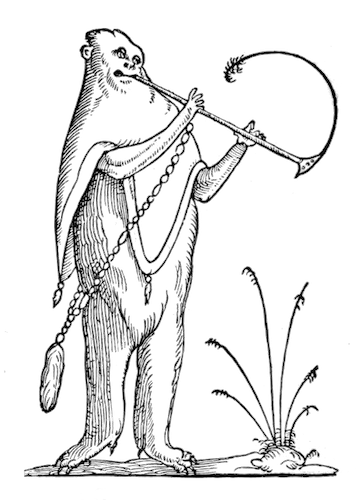
Essays

Handy Mnemonics: The Five-Fingered Memory Machine
Before humans stored memories as zeroes and ones, we turned to digital devices of another kind — preserving knowledge on the surface of fingers and palms. Kensy Cooperrider leads us through a millennium of “hand mnemonics” and the variety of techniques practised by Buddhist monks, Latin linguists, and Renaissance musicians for remembering what might otherwise elude the mind. more

Documenting Drugs: The Artful Intoxications of Stanisław Ignacy Witkiewicz
In pursuit of Pure Form, the Polish artist known as “Witkacy” would consume peyote, cocaine, and other intoxicants before creating pastel portraits. Juliette Bretan takes a trip through Witkiewicz’s chemical forays, including his 1932 Narcotics, a genre-bending treatise that warns of the hazards of drugs while seductively recollecting their delirious effects. more

Luigi Russolo’s Cacophonous Futures
What does the future sound like? In the early 20th century, one answer rang out from Luigi Russolo’s intonarumori — lever-operated machines designed to pop, sough, shriek, and shock. Peter Tracy explores the ambitions behind Italian Futurism’s experiments with noise and the sensory, spiritual, and political affinities of this radical new music. more

Love and Longing in the Seaweed Album
Combing across 19th-century shores, seaweed collectors would wander for hours, tucking specimens into pouches and jars, before pasting their finds into artful albums. Sasha Archibald explores the eros contained in the pressed and illustrated pages of notable algologists, including “the most ambitious album of all” by Charles F. Durant. more

“Pajamas from Spirit Land”: Searching for William James
After the passing of William James — philosopher, early psychologist, and investigator of psychic phenomena — mediums across the US began receiving messages from the late Harvard professor. Channelling these fragmentary voices, Alicia Puglionesi considers the relationship between communication, reputation, and survival after death. more

A Paper Archaeology: Piranesi’s Ruinous Fantasias
From the vast confines of his imaginary prisons to the billowy scenes that comprise his grotteschi, the early works of Giovanni Battista Piranesi wed the exacting details of first-hand observation with the farthest reaches of artistic imagination. Susan Stewart journeys through this 18th-century engraver-architect’s paper worlds. more

Of the 270,000 photographs commissioned by the US Farm Security Administration to document the Great Depression, more than a third were “killed”. Erica X Eisen examines the history behind this hole-punched archive and the unknowable void at its center. more

Beastly Clues: T. S. Eliot, Torquemada, and the Modernist Crossword
Just a few years after The Waste Land appeared — a poem whose difficulty critics compared to some “pompous cross-word puzzle” — Edward Powys Mathers (alias: Torquemada) pioneered the cryptic: a puzzle form that, like modernist poetry, unwove language and rewove it anew. Roddy Howland Jackson reveals the pleasures and imaginative creatures lurking in Torquemada's lively grids. more

Little Switzerlands: Alpine Kitsch in England
Far from the treacherous peaks and ravines of Switzerland, Alpine cottages arose, unexpectedly, amid the hillocks and modest streams of 19th-century England. Seán Williams recovers the peculiar fad for “Little Switzerlands”, where the Romantic sublime meets countryside kitsch. more

William Wells Brown, Wildcat Banker
A cottage industry, yes, but a barbershop bank? Ross Bullen plots how a story told by William Wells Brown — novelist, historian, playwright, physician, and escaped slave — circulated, first through his own works, and then abroad, as a parable of American banking gone bad. more

Laughter in the Time of Cholera
Political instability, popular unrest, and an impending pandemic? Welcome to France in the early 1830s. Vlad Solomon explores what made Parisians laugh in a moment of crisis through the prism of a vaudeville play. more

Marxist Astronomy: The Milky Way According to Anton Pannekoek
Can a person’s experiences on earth alter how they perceive the stars? Lauren Collee peers through the telescope of Anton Pannekoek, the Dutch astronomer whose politics informed his human approach to studying the cosmos. more

The Dust That Measures All Our Time
From the mythical Sandman, who participates in dream and vision, to an irritating grain lodged in the beachgoer’s eye, sand harbours unappreciated power, however mundane. Steven Connor celebrates this “most untrustworthy” type of matter. more

Mermaids and Tritons in the Age of Reason
For much of the eighteenth century, Western intellectuals chased after tritons and mermaids. Vaughn Scribner follows the hunt, revealing how humanity’s supposed aquatic ancestors became wondrous screens on which to project theories of geographical, racial, and taxonomical difference. more

Circassian Beauty in the American Sideshow
Among the “human curiosities” in P. T. Barnum’s American Museum was a supposed escapee from an Ottoman harem, a figure marketed as both the pinnacle of white beauty and an exoticised other. Betsy Golden Kellem investigates the complex of racial and cultural stereotypes that made the Circassian beauty such a sideshow spectacle. more

Why do helical seashells resemble spiralling galaxies and the human heart? Kevin Dann leads us into the gyre of James Bell Pettigrew’s Design in Nature (1908), a provocative and forgotten exploration of the world’s archetypal whorl. more

Picturing Scent: The Tale of a Beached Whale
What can visual art teach us about scent, stench, and the mysterious substance known as ambergris? Lizzie Marx follows a “whale-trail” across history to discover the olfactory paradoxes of the Dutch Golden Age. more

Reading Like a Roman: Vergilius Vaticanus and the Puzzle of Ancient Book Culture
How did Virgil’s words survive into the present? And how were they once read, during his own life and the succeeding centuries? Alex Tadel explores Graeco-Roman reading culture through one of its best-preserved and most lavishly-illustrated artefacts. more

Still Farther South: Poe and Pym’s Suggestive Symmetries
In 1838, as the United States began its Exploring Expedition to the South Seas, Edgar Allan Poe published a novel that masqueraded as a travelogue. John Tresch guides us along this strange trip southward, following the pull of its unfathomable mysteries. more

Photographing the Tulsa Massacre of 1921
On the evening of May 31, 1921, several thousand white citizens and authorities began to violently attack the prosperous Black community of Greenwood in Tulsa, Oklahoma. Karlos K. Hill investigates the disturbing photographic legacy of this massacre and the resilience of Black Wall Street’s residents. more
%2C_RP-P-OB-201.947-edit-thumb.jpg?w=600&h=1200&auto=format,compress)
The Art of Making Debts: Accounting for an Obsession in 19th-Century France
Being in debt was once an artful promenade — the process of eluding creditors through disguise and deceit. Erika Vause explores a forgotten financial history: the pervasive humor that once accompanied the literature and visual culture of debt. more

“The Mark of the Beast”: Georgian Britain’s Anti-Vaxxer Movement
Ox-faced children, elderly women sprouting horns, and cloven minds — all features attributed to Edward Jenner’s vaccine against smallpox. Introducing us to the original anti-vaxxers, Erica X Eisen explores the “vacca” in the first-ever vaccine: its bovine origins and the widespread worry that immunity came with beastly side effects. more

“Fevers of Curiosity”: Charles Baudelaire and the Convalescent Flâneur
This month marks the 200th anniversary of Charles Baudelaire’s birth, the French poet famous for his descriptions of the flâneur: a man of the crowd, who thrived in the metropolis’ multitude. Following Baudelaire through 19th-century Paris, Matthew Beaumont discovers a parallel archetype — the convalescent hero of modernity — who emerges from the sickbed into city streets with a feverish curiosity. more

Propagating Propaganda: Franklin Barrett’s Red, White, and Blue Liberty Bond Carp
Toward the end of World War I, as the US peddled hard its Liberty Bonds for the war effort, goldfish dealer Franklin Barrett bred a stars-and-stripes-colored carp: a living, swimming embodiment of patriotism. Laurel Waycott uncovers the story of this “Liberty Bond Fish” and the wider use of animals in propaganda of the time. more

